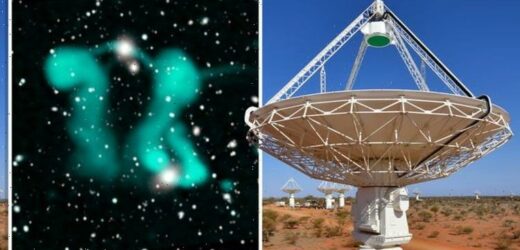China constructs 500 metre spherical radio telescope 'FAST'
We use your sign-up to provide content in ways you’ve consented to and to improve our understanding of you. This may include adverts from us and 3rd parties based on our understanding. You can unsubscribe at any time. More info
Researchers from Western Sydney University and Australia’s national science agency, CSIRO, detected the unusual phenomena about one billion miles from Earth. Officially dubbed MCC 2130-538, the spectral clouds were detected using the Australian Square Kilometre Array Pathfinder (ASKAP) radio telescope. According to Ray Norris, a professor at Western Sydney University, the astronomers initially had no clue what they had stumbled upon.
He said: “Scanning through data fresh off the telescope, we saw two ghosts dancing deep in the cosmos.
“We had never seen anything like it before, and we had no idea what they were.”
A close analysis of the data revealed the presence of two radio galaxies about one billion light-years away.
Radio galaxies are characterised by their active nuclei that emit powerful radio emissions.


In this particular case, a supermassive black hole sits in the centre of both galaxies, releasing jets of electrons out into space.
The electrons are then intercepted by intergalactic wind and bent and twisted out of shape into the ghost-like clouds the astronomers detected.
Professor Norris said: “But where does the intergalactic wind come from? Why is it so tangled?
“And what is causing the streams of radio emission?
“We still don’t understand the details of what is going on here, and it will probably take many more observations and modelling before we do.”
NASA: Hubble telescope spots comet near Jupiter
The discovery was made as part of the Evolutionary Map of the Universe (EMU) project.
EMU uses Australia’s ASKAP array of telescopes to probe farther into the Universe than other before.
Professor Norris discussed the team’s work in an article penned for The Conversation.
He said: “When you boldly go where no telescope has gone before, you are likely to make new discoveries.”
The effort has so far revealed a number of fascinating phenomena – and the “Dancing ghosts” were not the first major surprise.


This honour goes to the discovery of ringed-shaped radio emissions spanning nearly a million light-years across.
The astronomers named these the Odd Radio Circles or ORCs after spotting them around distant galaxies.
Professor Norris said: “These had never been seen before, because they are so rare and faint.
“We still don’t know what they are but we are working furiously to find out.”
The astronomers have also discovered an unexpected radio galaxy – one of the biggest ever found – nearby the galaxy IC 5063 some 156 million light-years away.
This galaxy also boasts a supermassive black hole at its centre, which is spewing jets of electrons nearly five million light-years long.
The Australian radio telescope is the only tool of its kind on the planet that can detect the faint emission.
Professor Norris added: “Over the next few years, EMU will use the ASKAP telescope to explore even deeper in the Universe, building on these discoveries and finding more.
“All the data from EMU will eventually be placed in the public domain, so that astronomers from around the world can mine the data and make new discoveries.”
Source: Read Full Article


